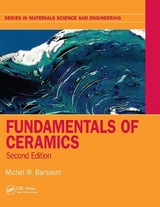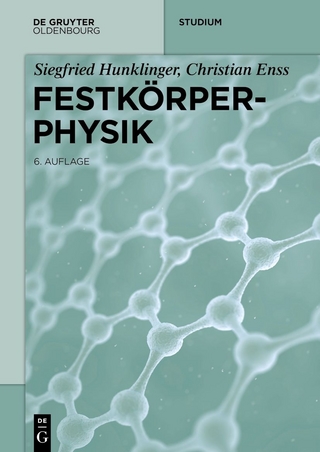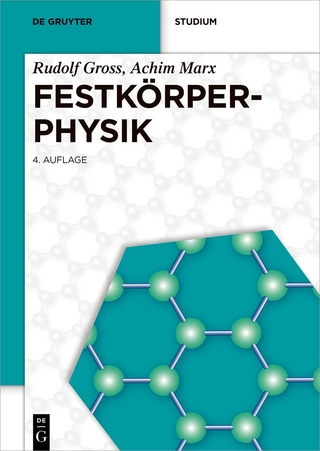
Fundamentals of Ceramics
Institute of Physics Publishing (Verlag)
978-0-7503-0902-8 (ISBN)
- Titel erscheint in neuer Auflage
- Artikel merken
Updated and improved, this revised edition of Michel Barsoum's classic text Fundamentals of Ceramics presents readers with an exceptionally clear and comprehensive introduction to ceramic science. Barsoum offers introductory coverage of ceramics, their structures, and properties, with a distinct emphasis on solid state physics and chemistry. Key equations are derived from first principles to ensure a thorough understanding of the concepts involved.
The book divides naturally into two parts. Chapters 1 to 9 consider bonding in ceramics and their resultant physical structures, and the electrical, thermal, and other properties that are dependent on bonding type. The second part (Chapters 11 to 16) deals with those factors that are determined by microstructure, such as fracture and fatigue, and thermal, dielectric, magnetic, and optical properties. Linking the two sections is Chapter 10, which describes sintering, grain growth, and the development of microstructure.
Fundamentals of Ceramics is ideally suited to senior undergraduate and graduate students of materials science and engineering and related subjects.
INTRODUCTION
Introduction
Definition of Ceramics
Elementary Crystallography
Ceramic Microstructures
Traditional Versus Advanced Ceramics
General Characteristics of Ceramics
Applications
The Future
BONDING IN CERAMICS
Introduction
Structure of Atoms
Ionic versus Covalent Bonding
Ionic Bonding
Ionically Bonded Solids
Covalent Bond Formation
Covalently Bonded Solids
Band Theory of Solids
Summary
Appendix 2A: Kinetic Energy of Free Electrons
STRUCTURE OF CERAMICS
Introduction
Ceramic Structures
Binary Ionic Compounds
Composite Crystal Structures
Structure of Covalent Ceramics
Structure of Silicates
Lattice Parameters and Density
Summary
Appendix 3A: Ionic Radii
EFFECT OF CHEMICAL FORCES ON PHYSICAL PROPERTIES
Introduction
Melting Points
Thermal Expansion
Young's Modulus and the Strength of Perfect Solids
Surface Energy
Summary
THERMODYNAMIC AND KINETIC CONSIDERATIONS
Introduction
Free Energy
Chemical Equilibrium and the Mass Action Expression
Chemical Stability Domains
Electrochemical Potentials
Charged Interfaces, Double Layers, and Debye Lengths
Gibbs-Duhem Relation for Binary Oxides
Kinetic Considerations
Summary
Appendix 5A: Derivation of Eq. (5.27)
DEFECTS IN CERAMICS
Introduction
Point Defects
Linear Defects
Planar Defects
Summary
DIFFUSION AND ELECTRICAL CONDUCTIVITY
Introduction
Diffusion
Electrical Conductivity
Ambipolar Diffusion
Relationships between Self-, Tracer, Chemical, Ambipolar, and Defect Diffusion Coefficients
Summary
Appendix 7A: Relationship between Fick's First Law and Eq. (7.30)
Appendix 7B: Effective Mass and Density of States
Appendix 7C: Derivation of Eq. (7.79)
Appendix 7D: Derivation of Eq. (7.92)
PHASE EQUILIBRIA
Introduction
Phase Rule
One-Component Systems
Binary Systems
Ternary Systems
Free-Energy Composition and Temperature Diagrams
Summary
FORMATION, STRUCTURE, AND PROPERTIES OF GLASSES
Introduction
Glass Formation
Glass Structure
Glass Properties
Glass-Ceramics
Summary
Appendix 9A: Derivation of Eq. (9.7)
SINTERING AND GRAIN GROWTH
Introduction
Solid-State Sintering
Liquid-Phase Sintering
Hot Pressing and Hot Isostatic Pressing
Summary
Appendix 10A: Derivation of the Gibbs-Thompson Equation
Appendix 10B: Radii of Curvature
Appendix 10C: Derivation of Eq. (10.20)
Appendix 10D: Derivation of Eq. (10.22)
MECHANICAL PROPERTIES: FAST FRACTURE
Introduction
Fracture Toughness
Strength of Ceramics
Toughening Mechanisms
Designing with Ceramics
Summary
CREEP, SUBCRITICAL CRACK GROWTH, AND FATIGUE
Introduction
Creep
Subcritical Crack Growth
Fatigue of Ceramics
Lifetime Predictions
Summary
Appendix 12A: Derivation of Eq. (12.24)
THERMAL PROPERTIES
Introduction
Thermal Stresses
Thermal Shock
Spontaneous Microcracking of Ceramics
Thermal Tempering of Glass
Thermal Conductivity
Summary
DIELECTRIC PROPERTIES
Introduction
Basic Theory
Equivalent Circuit Description of Linear Dielectrics
Polarization Mechanisms
Dielectric Loss
Dielectric Breakdown
Capacitors and Insulators
Summary
Appendix 14A: Local Electric Field
MAGNETIC AND NONLINEAR DIELECTRIC PROPERTIES
Introduction
Basic Theory
Microscopic Theory
Para-, Ferro-, Antiferro-, and Ferrimagnetism
Magnetic Domains and the Hysteresis Curve
Magnetic Ceramics and their Applications
Piezo- and Ferroelectric Ceramics
Summary
Appendix 15A: Orbital Magnetic Quantum Number
OPTICAL PROPERTIES
Introduction
Basic Principles
Absorption and Transmission
Scattering and Opacity
Fiber Optics and Optical Communication
Summary
Appendix 16A: Coherence
Appendix 16B: Assumptions Made in Deriving Eq. (16.24)
INDEX
*Each chapter contains Problems and Additional Reading.
| Erscheint lt. Verlag | 27.11.2002 |
|---|---|
| Reihe/Serie | Series in Materials Science and Engineering |
| Verlagsort | London |
| Sprache | englisch |
| Maße | 156 x 234 mm |
| Gewicht | 1066 g |
| Themenwelt | Naturwissenschaften ► Physik / Astronomie ► Festkörperphysik |
| Technik ► Maschinenbau | |
| ISBN-10 | 0-7503-0902-4 / 0750309024 |
| ISBN-13 | 978-0-7503-0902-8 / 9780750309028 |
| Zustand | Neuware |
| Haben Sie eine Frage zum Produkt? |
aus dem Bereich



